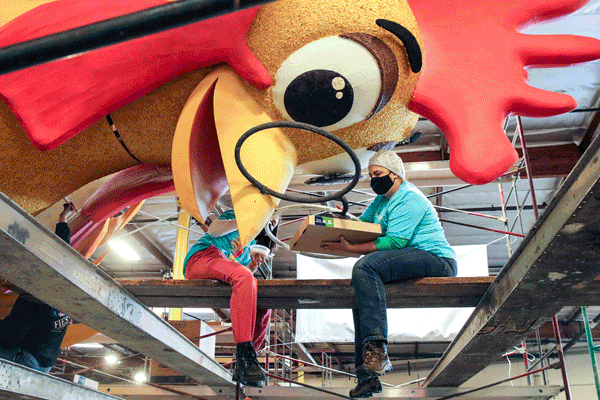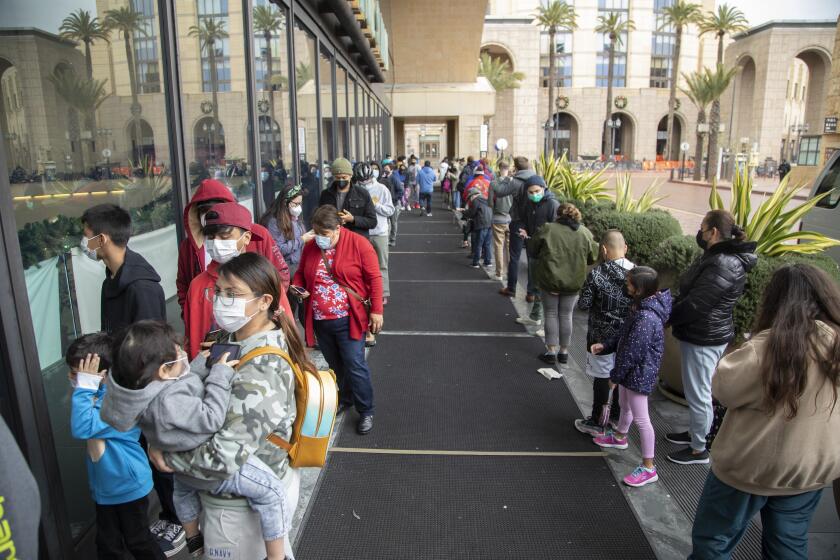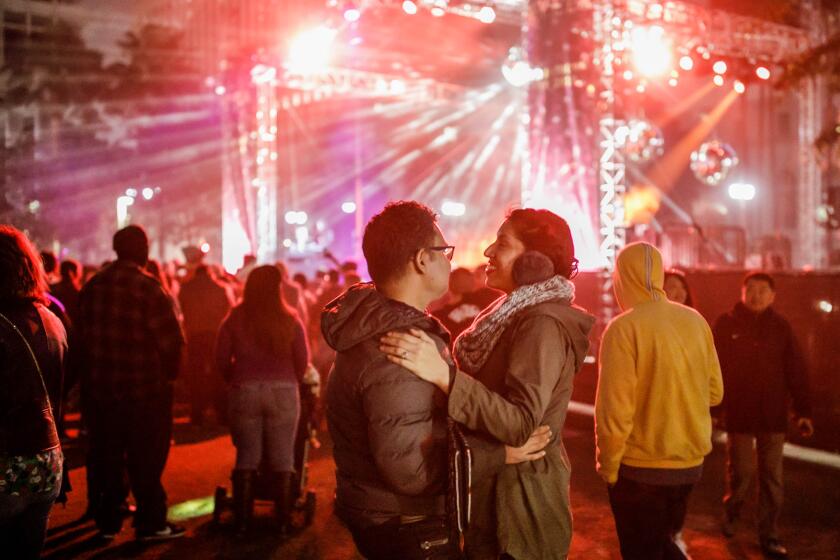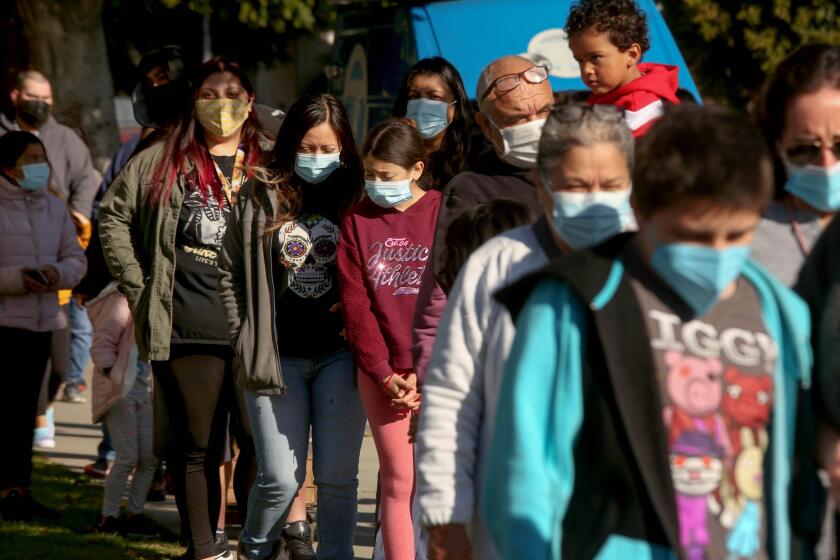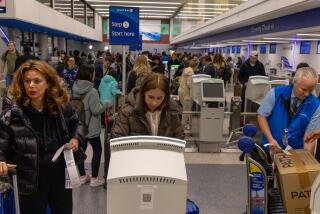Unprecedented coronavirus cases have officials urging scaled-back New Year’s celebrations
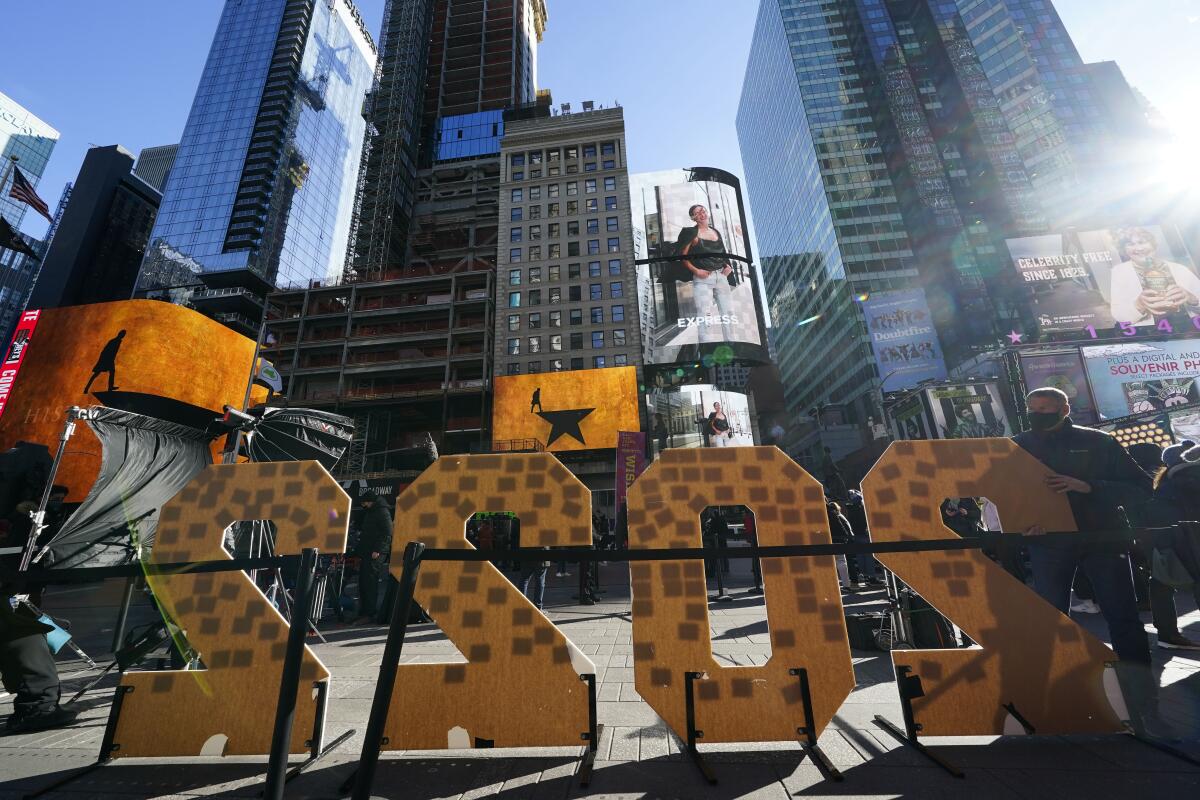
- Share via
With the highly infectious Omicron variant sending coronavirus cases soaring to unprecedented levels, California’s winter surge has entered another perilous phase, prompting renewed calls by health officials to dial back celebratory plans and avoid crowded settings over the New Year’s holiday weekend.
The warnings come as the nationwide number of newly confirmed coronavirus infections roared to a record high and hospitalizations in California and elsewhere continue to increase.
Though officials said preliminary evidence was increasingly showing Omicron causes less severe illness than the still-prevalent Delta variant — especially for otherwise healthy people who have been vaccinated — the number of people getting infected has raised alarms as officials work to shore up hospital capacity and ensure other vital services aren’t interrupted.
“We know the Omicron variant is airborne and highly transmissible, and that a combination of colder weather, indoor gatherings and holiday-related household mixing would likely result in an increase in cases,” officials with the California Department of Public Health said in a statement.
Soaring COVID-19 cases fueled by the fast-spreading Omicron variant are prompting fresh concerns about end-of-year gatherings.
That’s why it’s crucial, state health officials said, “that everyone take steps to protect their health and slow the spread of COVID-19.”
While those include long-cited measures such as getting vaccinated and boosted, getting tested, wearing masks indoors while in public and staying home if you feel sick, officials also say more cautious New Year’s celebrations can help.
“Small intimate gatherings is the way to go this New Year’s. It’s not the time to go to a large gathering,” said Dr. Sara Cody, the public health director and health officer for Santa Clara County. “The only exception would be if you’re going to spend the entire gathering outdoors.”
Anxiety surrounding holiday travel and gatherings is nothing new in the era of COVID-19, and the progress made in the year-old vaccination campaign has not completely snuffed out such fears.
In L.A. County — which on Wednesday reported 16,510 new coronavirus cases, one of the highest single-day totals of the pandemic — health officials urged residents “to scale down New Year’s plans by limiting gatherings to a very small number of people where everyone is fully vaccinated and boosted, if eligible,” health officials said in a statement.
“As cases continue to rise, it is important that we all use the tools available to help us curb the spread,” Public Health Director Barbara Ferrer said. “As we get ready to welcome the new year, this includes re-thinking party plans, limiting time indoors with non-household members and isolating from others if feeling sick. And always wear a medical-grade mask when in close contact with others outside your household.”
Floats are being decorated, marching bands are tuning up and thousands are bundling up to see the spectacle. But the pandemic lurks in the background.
New Year’s celebrations will probably be less muted than last year. While some fireworks shows and holiday to-dos are being canceled or going virtual because of the infection risk, others — including the beloved Rose Parade — are scheduled to make a much-anticipated return.
But officials are strongly cautioning against any full-blown affairs — or at least limiting them to a small number of guests whose vaccination and coronavirus testing status are known.
“If your plans are to go to a 40- to 50-person New Year’s Eve party with all the bells and whistles and everybody hugging and kissing and wishing each other a happy new year, I would strongly recommend that this year, we do not do that,” said Dr. Anthony Fauci, the White House’s top medical advisor.
He did note during a briefing Wednesday that “we feel you should continue to go through with those plans of having a home-related, vaccinated, boosted gathering, with family and close friends who are also vaccinated and boosted.”
Residents looking for more peace of mind can also take a rapid coronavirus test as soon as possible before an event or get-together, officials say.
“It just seems that I could have a better proxy of people’s infectiousness by doing a rapid test, if I can get them,” said Dr. Peter Chin-Hong, a UC San Francisco infectious-disease expert.
The winter spread of coronavirus cases is worsening. Here’s the latest advice on protecting yourself and those around you.
As always, officials said outdoors is safer than indoors, especially for larger gatherings. They also noted, though, that people should still mask up in any crowded setting, be it inside or out.
What counts as crowded depends on whom you ask and your own risk factors. Cody, for instance, suggested that if you gather indoors — even in your own home — with more than 10 people from outside your household, “we really urge you to keep your masks on.”
Dr. Robert Kim-Farley, a medical epidemiologist and infectious-disease expert at the UCLA Fielding School of Public Health, also advised against crowded New Year’s Eve gatherings indoors, especially where people might be singing and dancing in close quarters.
Watching fireworks outside would be a safer activity, but he suggested people still wear masks in crowded outdoor settings.
Some areas, however, have deemed even fireworks shows to be too risky this year. San Francisco, for instance, has nixed its display along the Embarcadero.
“By canceling the New Year’s Eve fireworks show, we are reducing everyone’s exposure to COVID-19 while ensuring continuity of citywide public safety operations,” Mayor London Breed said in a statement.
San Francisco and other Bay Area communities are dropping policies that allowed people to go maskless in some indoor settings.
Similar calls for celebratory caution were also the norm leading up to Christmas, which arrived during the nascent stage of a new surge in infections that has continued to grow.
Fueled by a potent tag team — the Delta and Omicron variants, perhaps the two most easily transmissible versions of the coronavirus to date — case counts have soared in California and across the country.
Over the last week, California has reported an average of nearly 20,500 new coronavirus cases per day, according to data compiled by The Times. That level of infection is well above any seen during last summer’s surge, and represents a 228% increase compared with two weeks ago.
Nationwide, the Centers for Disease Control and Prevention reported Wednesday that the average number of daily cases over the last week has climbed beyond 277,000, exceeding the peak of 160,000 during the summer Delta surge and the all-time high of 250,000 reported last winter.
“The rapid increase in cases we are seeing across the country is in large part a reflection of the exceptionally transmissible Omicron variant,” CDC Director Dr. Rochelle Walensky said during a briefing.
But while Omicron has helped spur a significant rise in cases, preliminary data continue to show the variant may result in less severe disease than Delta, Fauci said.
Cases from Britain and South Africa showed reduced risk of hospitalizations, Fauci said during a White House briefing Wednesday. In recent reports from Scotland, the risk of hospitalization with Omicron was 66% lower than in previous waves.
South Africa reported that among patients who did end up in the hospital, they stayed an average of four days, compared with 8.8 days during the Delta wave.
A sharp spike in COVID cases, fueled in part by the Omicron variant, prompts health experts to urge revelers to scale back New Year’s Eve gatherings.
Currently in the U.S., data suggest that “the spike in cases is out of proportion to the increase in hospitalization,” Fauci said. As of Tuesday night, the 14-day average shows a 126% increase in cases and an 11% increase in hospitalizations.
“We must remember that hospitalizations and deaths are lagging indicators,” he said. “However, the pattern and disparity between cases and hospitalizations strongly suggests that there will be a lower hospitalization-to-case ratio when the situation becomes more clear.”
COVID-19 hospitalizations are also rising in California, though they remain well below what the state saw during either the summer Delta surge or last winter’s devastating wave. As of Tuesday, 4,759 coronavirus-positive patients were hospitalized statewide, a nearly 33% increase from a week ago.
It’s unclear whether this increase is primarily the work of Omicron or Delta.
Health officials say it’s important to improve the fit of face masks and their filtration, going beyond old, loose, cloth face coverings.
In the near term, some health officials are also warning against dining indoors or traveling, given the amount of coronavirus circulating.
Kim-Farley suggested that people rethink vacations, such as a getaway trip to Hawaii. While transmission is probably not particularly likely on the flight itself, there is risk during other parts of travel, Kim-Farley said.
“If you had an essential trip that you felt was important, yes. But if you’ve got something that’s nonessential, it just may be wise to wait a month or two — because we will see this peak and we will see it go back down again,” he said.
More to Read
Sign up for Essential California
The most important California stories and recommendations in your inbox every morning.
You may occasionally receive promotional content from the Los Angeles Times.

